Reviewer's Note: The M2XC4 3xCree R2 (Cool) was provided for review by EagleTac. The P7-based M2C4 will also be reviewed at a later date, as EagleTac will be sending me one from the next batch.
Warning: very pic heavy, as always
UPDATE AUGUST 12, 2009: My review of the second batch M2C4 (P7) is now up. Please see that review for an updated discussion of the build features of the M2-series lights.
The M2X family of lights from EagleTac have been highly anticipated, due to (among other things) a novel parallel battery tube design and magnetically-controlled switching ring. Here you will see how they compare to some of the multi-emitter competition, starting with the M2XC4 3xCree (cool white).
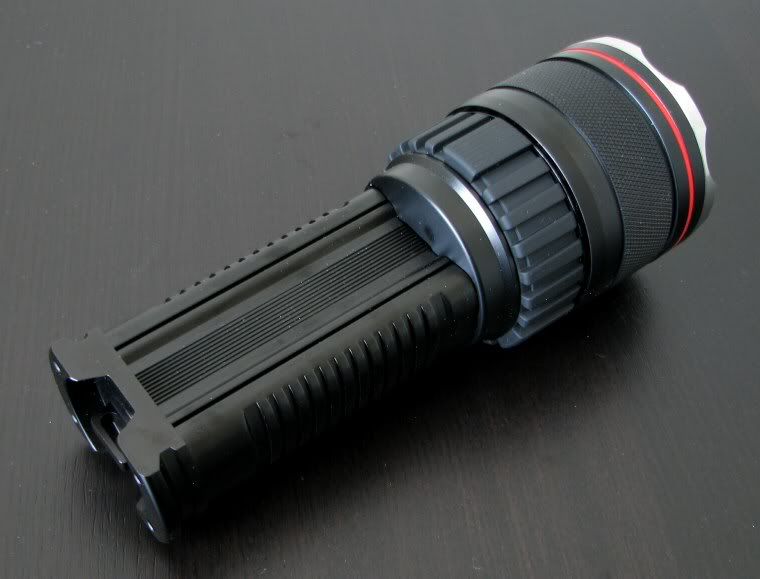
M2XC4 Cool specs (from the manufacturer):
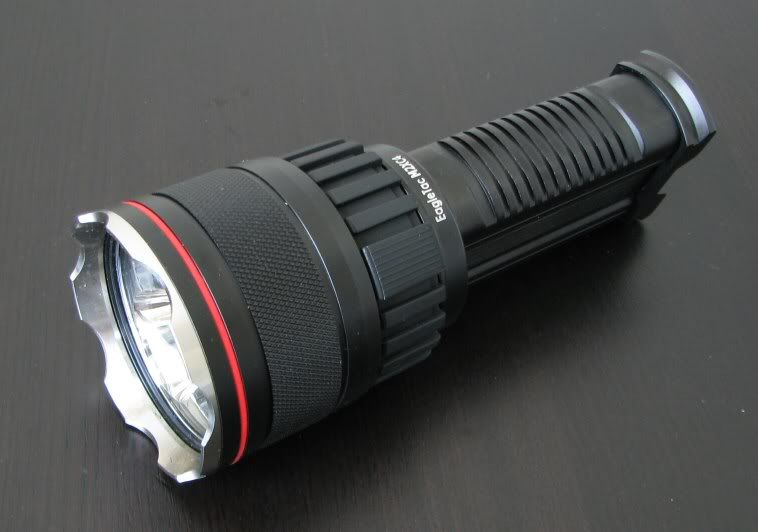
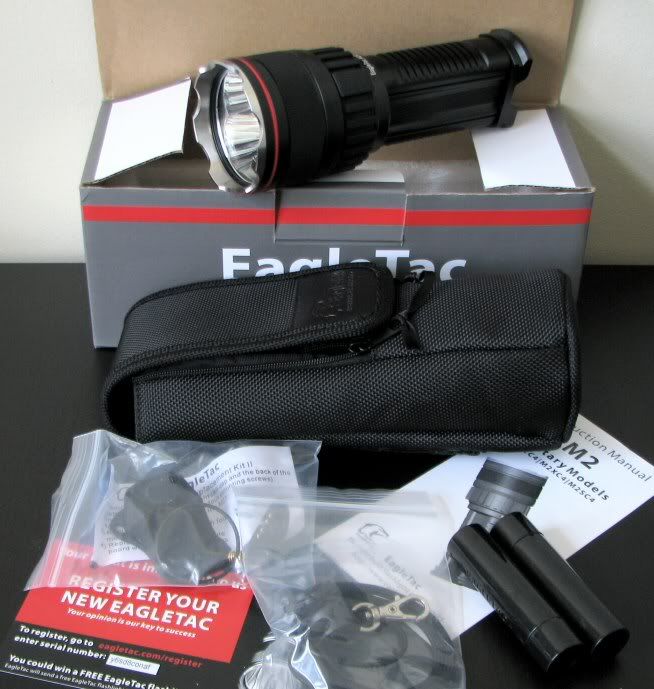
The EagleTac comes with the standard set of extras, like extra o-rings, wrist lanyard, warranty card and manual, and a few extras like primary battery holders, and a good quality nylon case that fits the light well. Also included with this initial run is the optional clicky switch kit (more on that in a moment).
EagleTac is preparing to offer a number of additional accessories that can be purchased separately, such as a diffuser and colored filters. With this review sample, they also included two of their own branded protected 18650 batteries (2400mAh rated capacity).
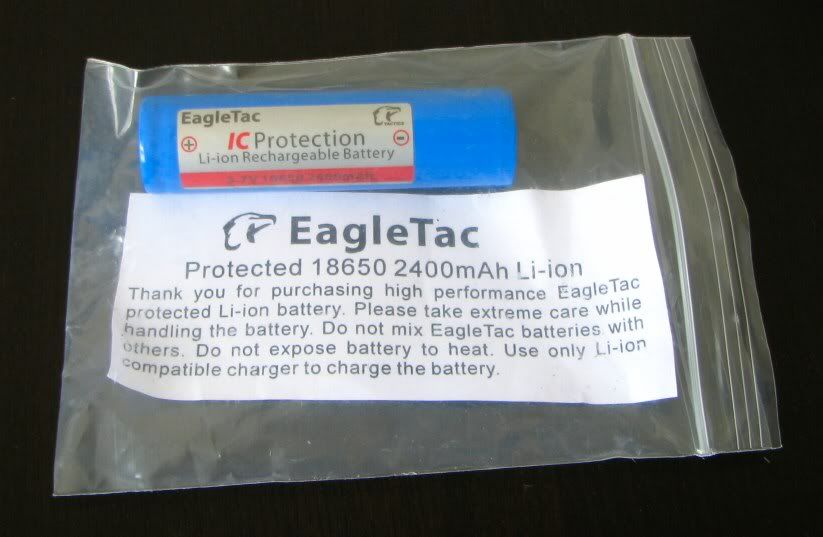
One of the most obviously distinctive features of the M2X series of lights is their parallel battery configuration. This is achieved through the use of a battery carrier inside the "handle" of the light. Note the all-black type III (HA) anodizing. My sample came very well lubed.
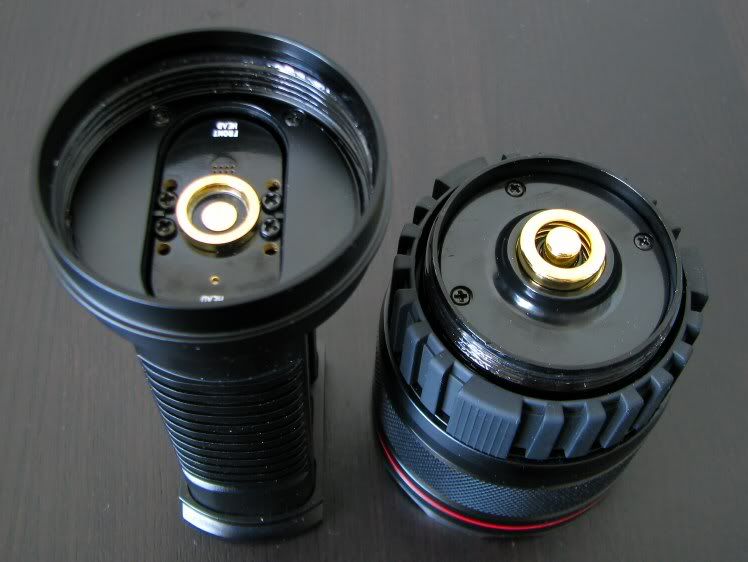
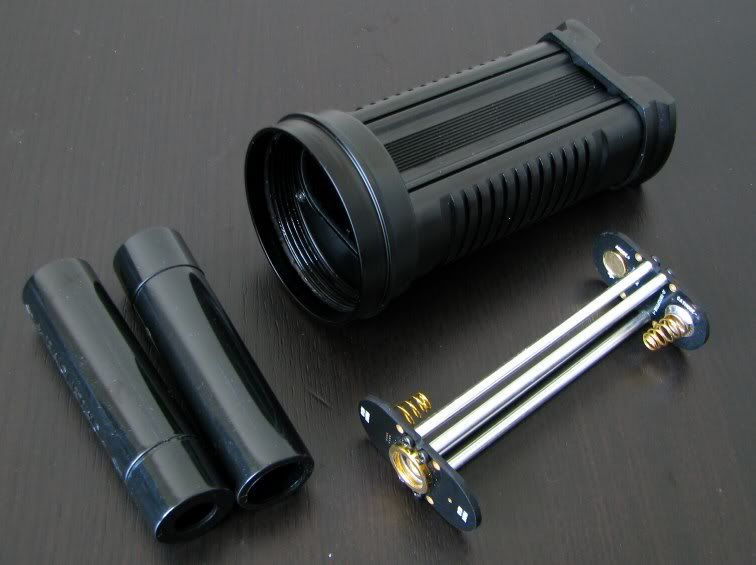
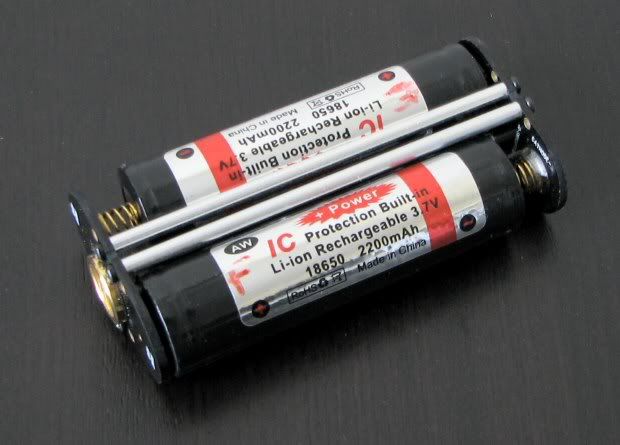
18650 batteries fit fairly snugly inside the carrier, but I recommend you use the included primary cell holder tubes for CR123A (prevents rattle, and holds everything together well).
The battery/body tube is attached to the tail-plate and head region base by two series of four small screws. Here is the the head region:
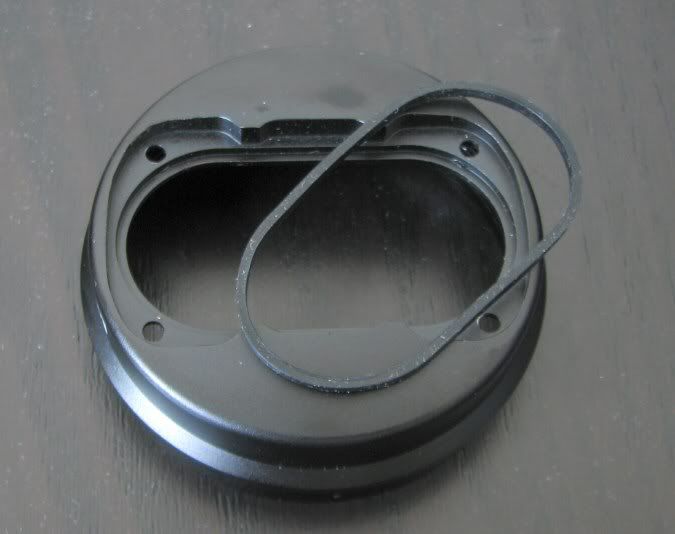
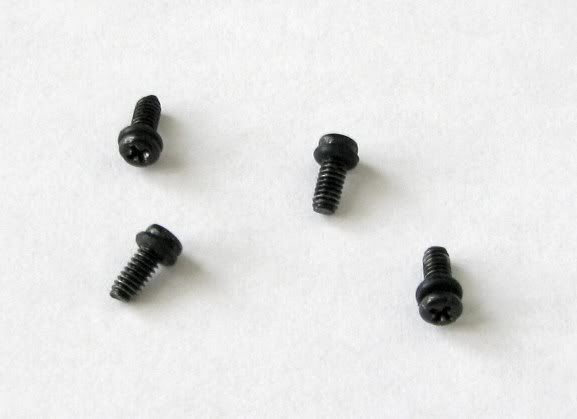
Note the presence of o-rings on each of four screws (these are needed for waterproofness, given the design). Here is the tail region, in stock form:

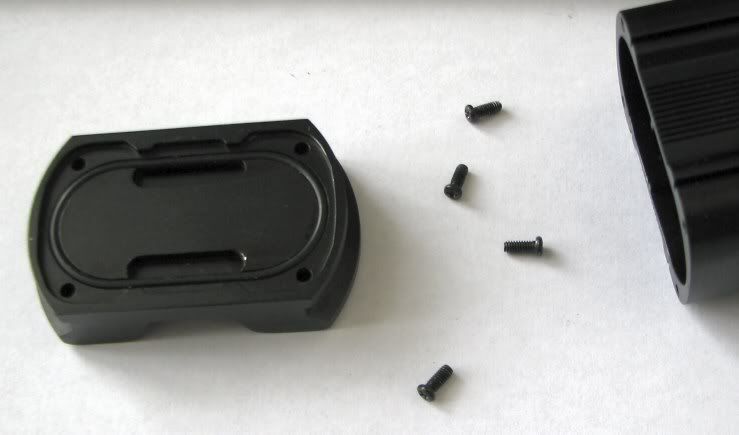
The standard tailcap is a different design than the head region, and the main o-ring appears to be sufficient to provide sufficient waterproofness (thus no o-rings on these screws). The light can tailstand in this default configuration, and there is an attachment point for the lanyard.
The light also comes with an optional clicky-switch kit:
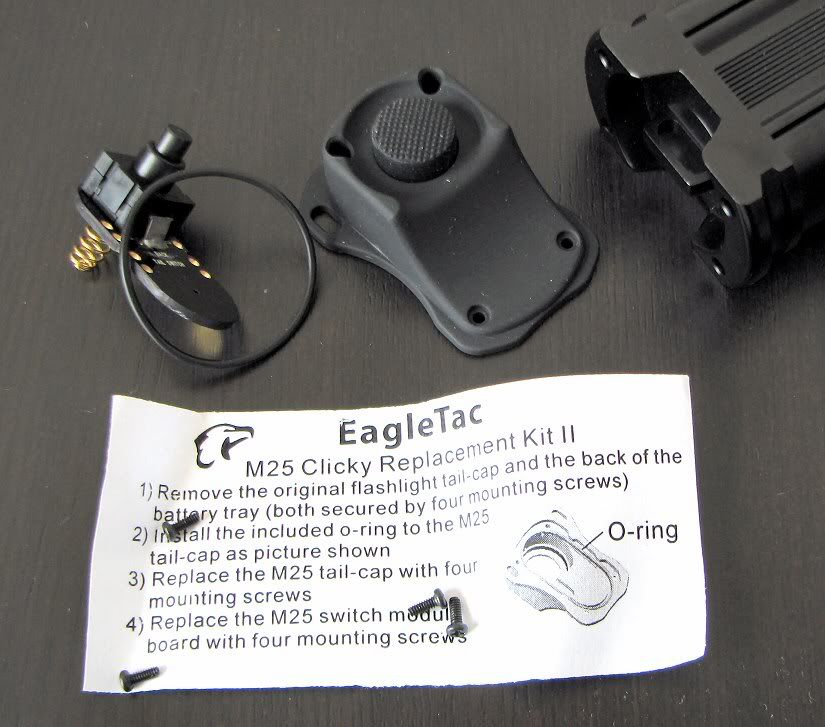
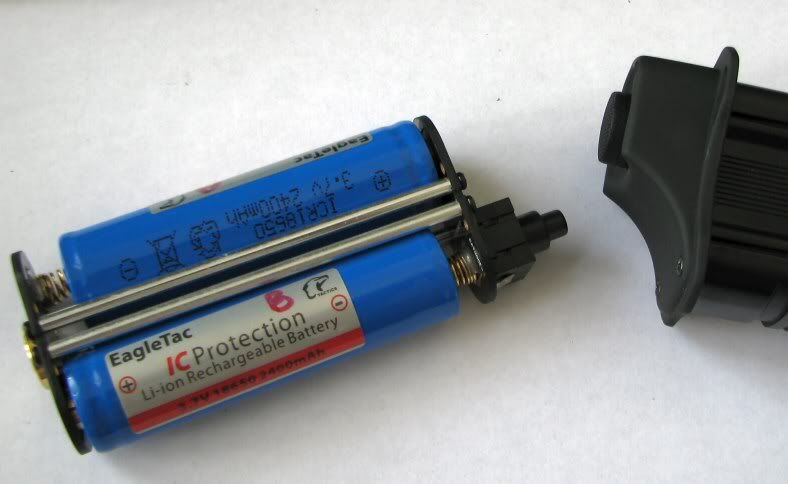
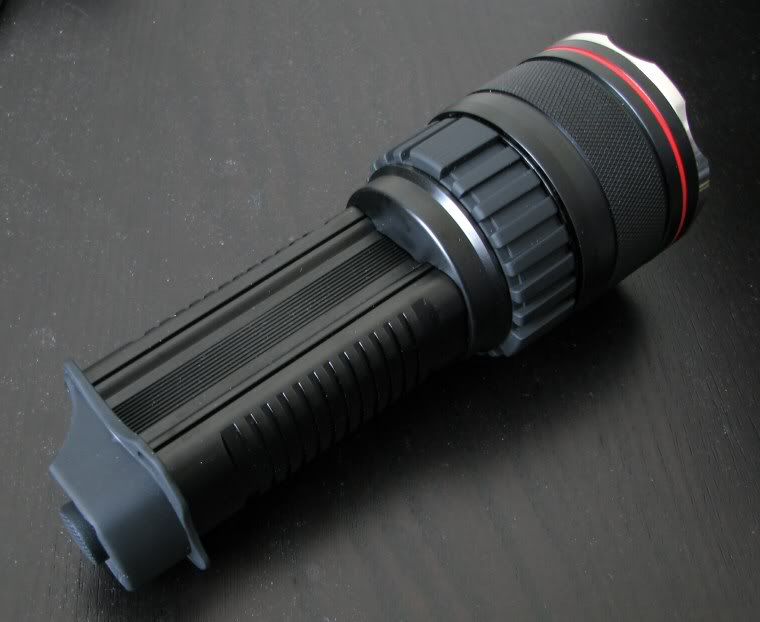
To swap in the clicky, you will need to disassemble both the back plate and the rear of the battery carrier. This requires the proper tool – a small Phillips-head jeweler's screwdriver. Care has to be used when assembling/disassembling so that you don't actually strip the screws – this is a fairly delicate procedure. The screws on my battery carrier required a lot of force to undo.
 I also found it a bit tricky to properly seat the o-ring on the clicky switch module. If you are not careful, the o-ring will bulge inward and reduced waterproofness. The design of the flat metal tail piece seems to hold the o-ring in place better. In fact, I had better success by using the original o-ring instead of the replacement that came with the clicky switch kit.
I also found it a bit tricky to properly seat the o-ring on the clicky switch module. If you are not careful, the o-ring will bulge inward and reduced waterproofness. The design of the flat metal tail piece seems to hold the o-ring in place better. In fact, I had better success by using the original o-ring instead of the replacement that came with the clicky switch kit.
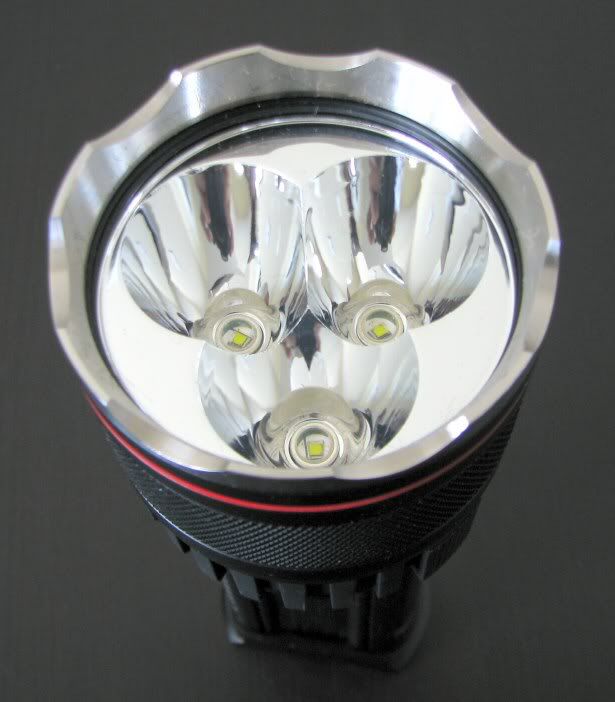
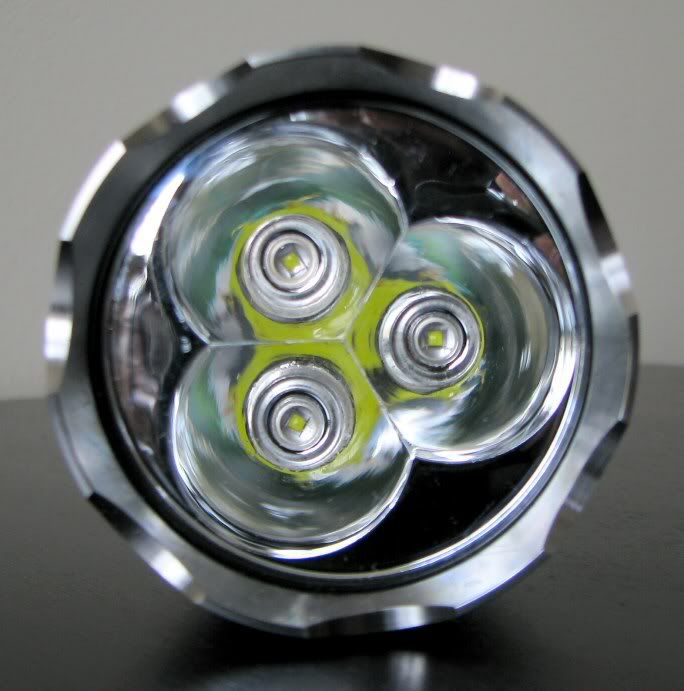
The 3xCree M2X lights use a common reflector with 3 partially overlapping wells for the emitters. This will give something of a "daisy" beam pattern up-close, but won't be an issue at a distance. My sample is the one with "cool" ~6000K color temperature Cree R2 emitters. Note the removable stainless steel bezel ring with slight crenelations.

Key to using the light is the rotary grip ring at the base of the head. This is made of polycarbonate (i.e. plastic) with a fairly "grippy" feel. It slides smoothly over ~110 degree arc, which runs in sequence as you turn clockwise from Off, through Lo, Med, Hi, Turbo, and Strobe (measured at 8 Hz on my sample). I've tried to illustrate this graphically below, starting at the 12 o'clock position and turning to the right (clockwise if holding the light and pointing away from you).
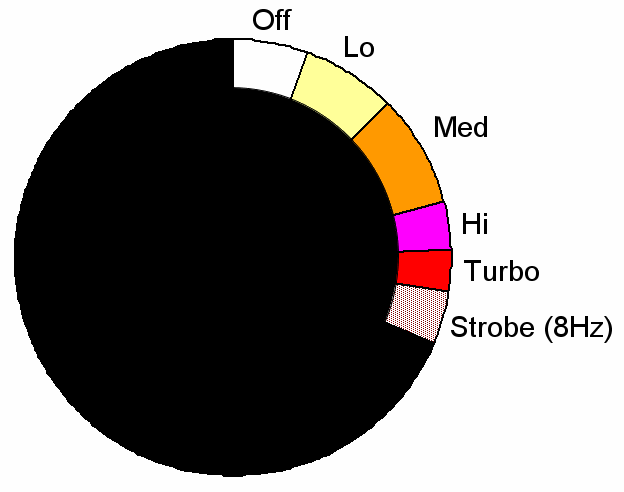
This rotary dial controls mode switching by the presence of a small embedded magnet. As it passes over various control points on the circuit, it triggers the different modes. Note that the modes are not evenly spaced along the ring. As many users have noticed, it is hard to get into Turbo mode without accidentally over-shooting into strobe instead. There are various ways to improve this – from simple mods to prevent the grip ring from making its full arc, to resoldering components on the inside of the circuit (search the main board for some discussion threads if you are interested in learning more).
With the standard flat tailcap installed, I find this ring works well only in traditional flashlight carry mode (i.e. underhand). In overhand "tactical" stance, it is hard to control the ring. But with the forward clicky kit installed, you can set the ring to your desired output mode and simply control on/off by a thumb-press in tactical overhand stance. Note that it is not as comfortable to hold the light underhand with the clicky switch installed, since the polycarbonate tailcap piece projects out wider than the width of the battery tube "handle".
Speaking of holding it, here's how it looks in my hands:
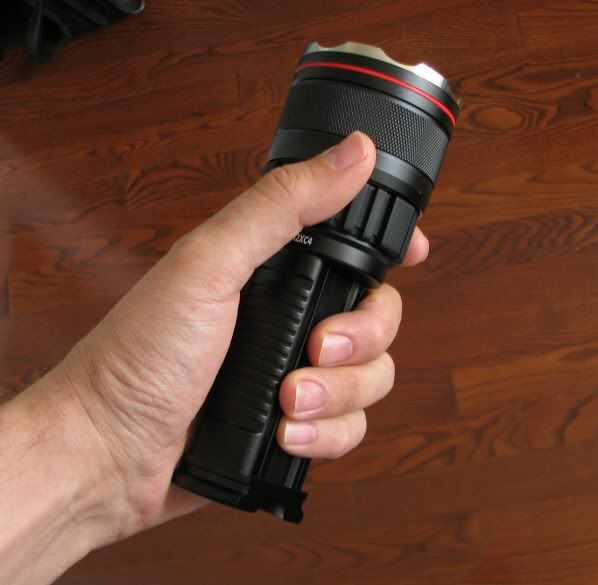
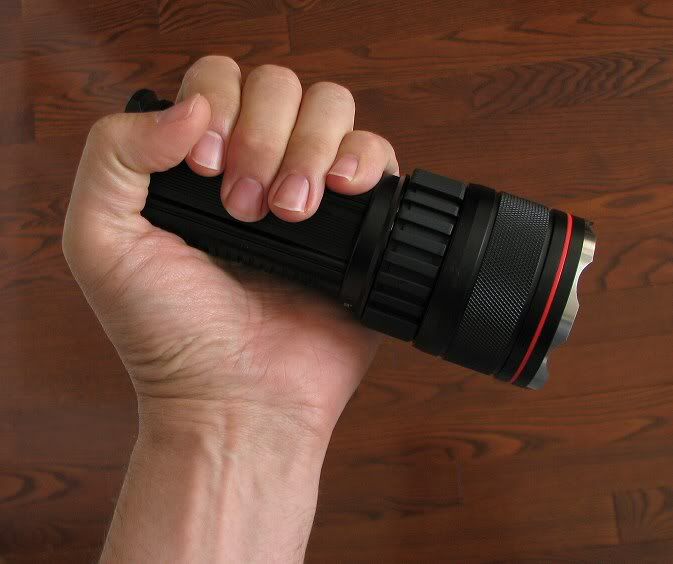
Dimensions (no batteries installed):
Height: 160mm
Width: 49mm (solid tailcap max width), 25mm (body tube minimum width), 61mm (bezel)
Weight: 395.8g
The M2XC4 is very substantial feeling, and heavier than I had expected. The light is in fact top-heavy, suggesting a good heatsinking base in the head (I understand the P7 version is not as top-heavy – I will update when that review sample arrives). IMO, it is more comfortable to carry underhand without the clicky. Given the ergonomics, there has been some concern that the light may be awkward to carry in use for long periods of time. :shrug: While I understand these concerns, the light doesn't seem too unbalanced to me, just rather beefy.
Here's how it compares to the competition (without battery extenders in place):
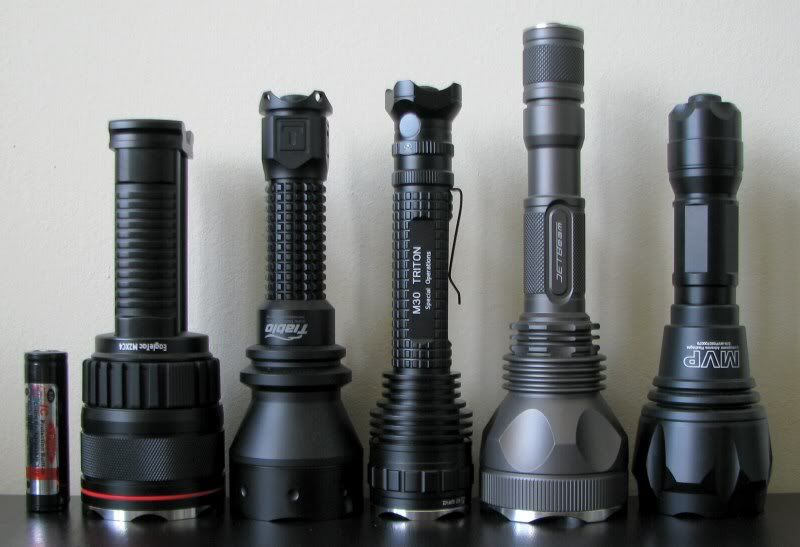
(from left to right, AW 18650 protected battery, EagleTac M2XC4, Tiablo ACE-G, Olight M30 Triton, JetBeam M1X, , Lumapower MVP 3xCree).
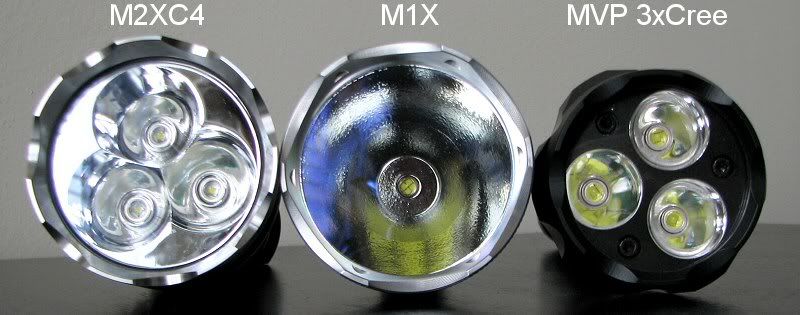
Comparison Beamshots
Both lights are on Max on 2x18650 AW protected Li-ion. Distance is about 0.5 meters from a white wall.
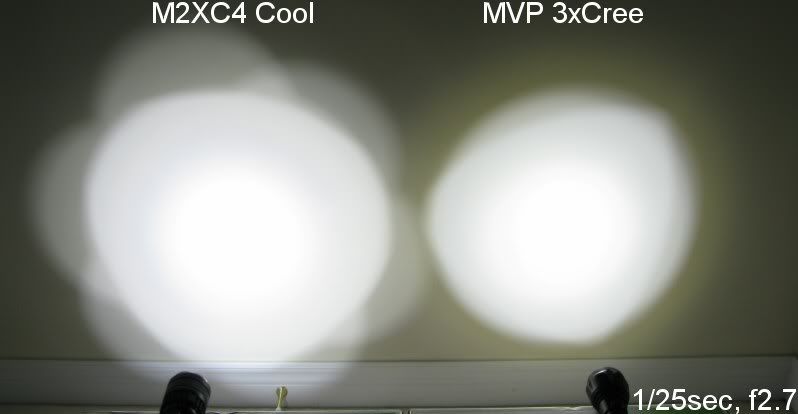
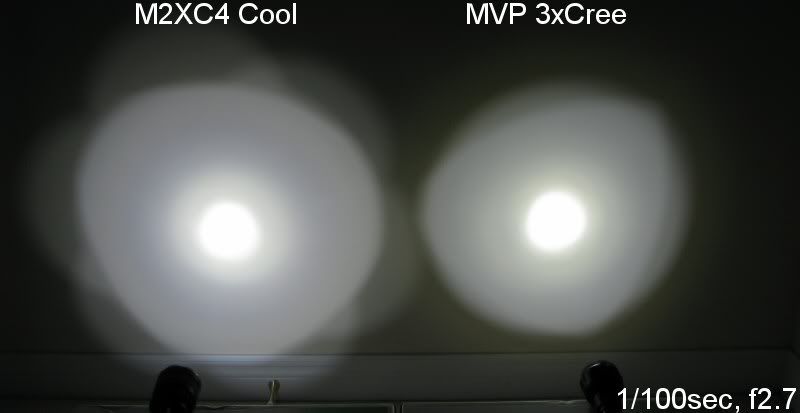
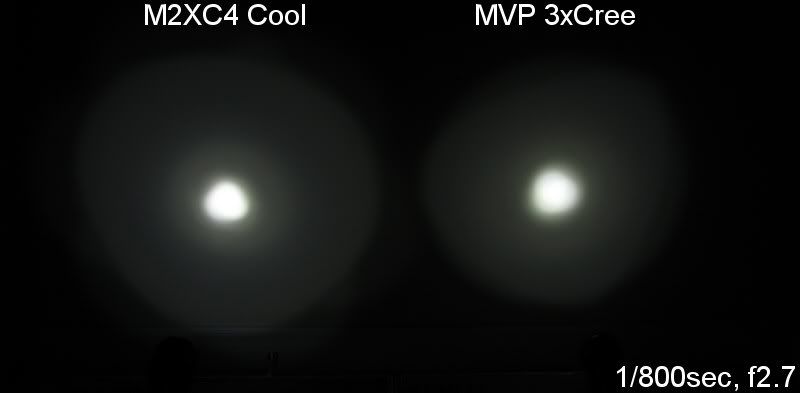
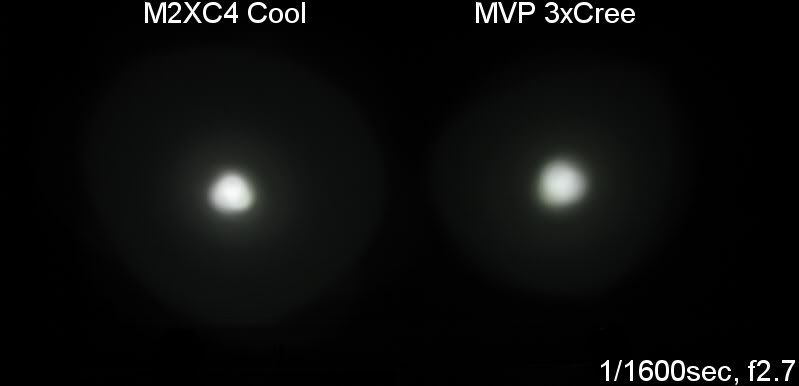
Up close, the M2XC4 has the typical "daisy" flower appearance customary to shared 3x reflector designs. The MVP 3xCree is a bit different, since each emitter has its own separate reflector cone.
To better compare the M2XC4 to other lights, here are some outdoor shots focused on a point ~30 feet from the lights.
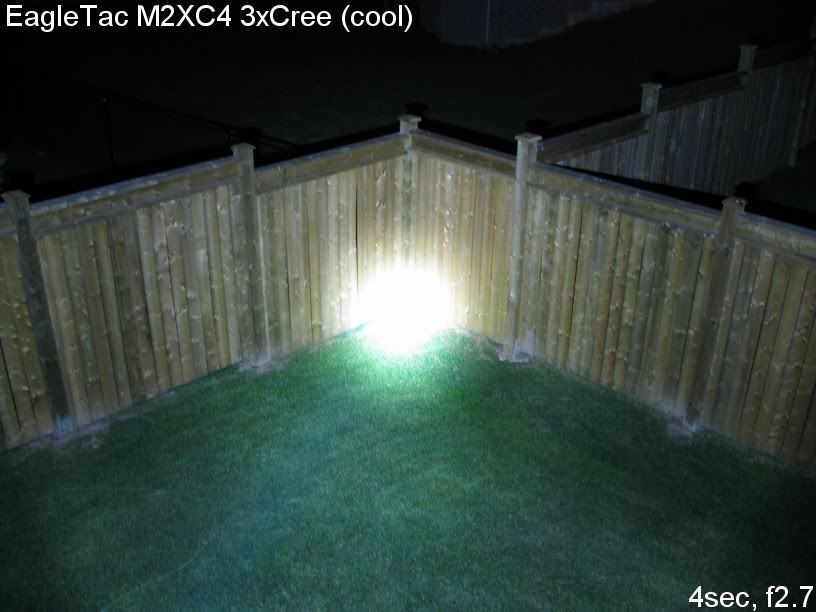
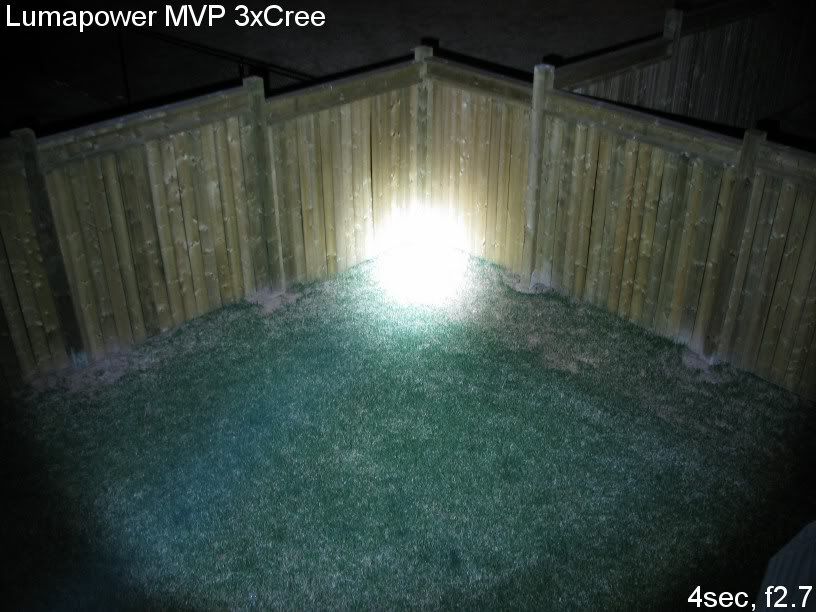
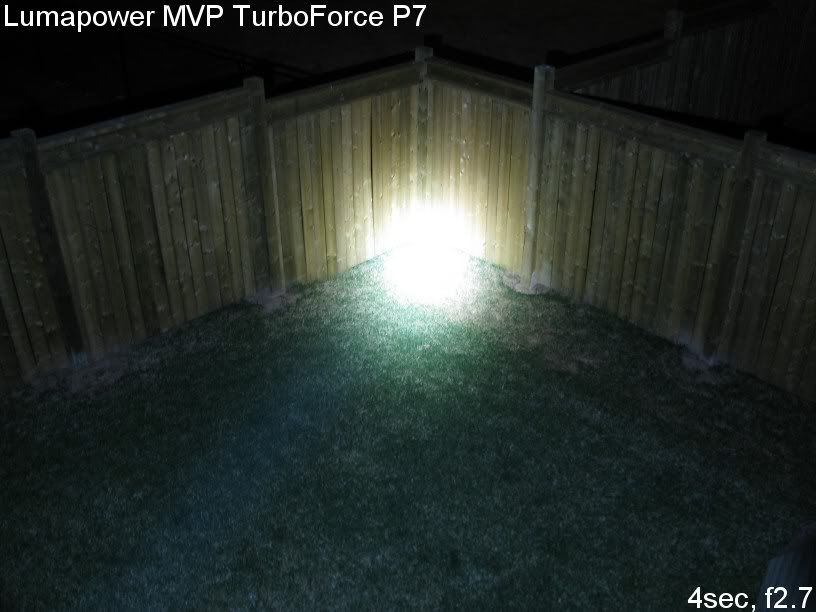
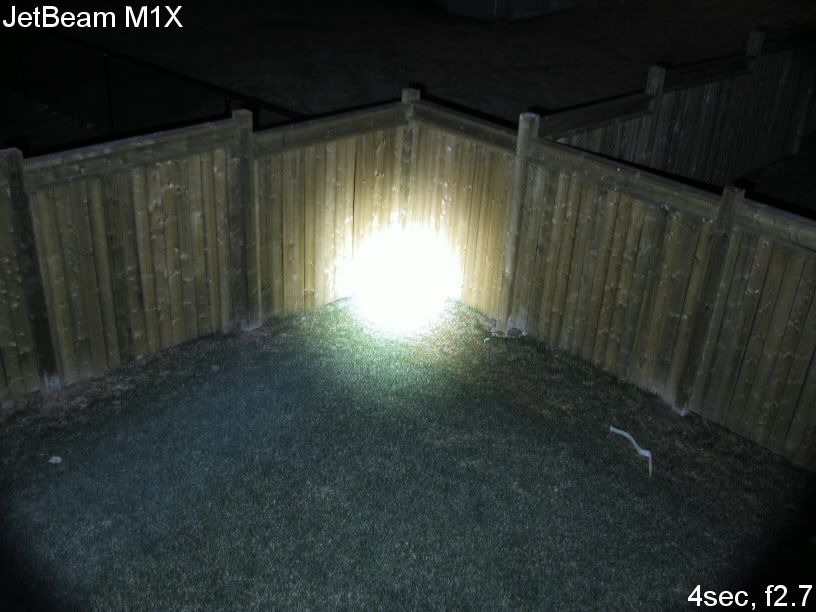
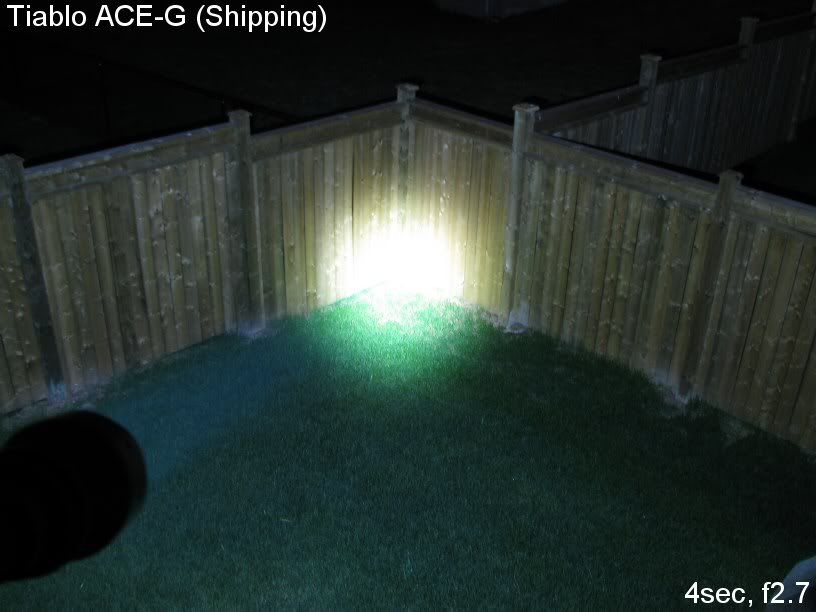
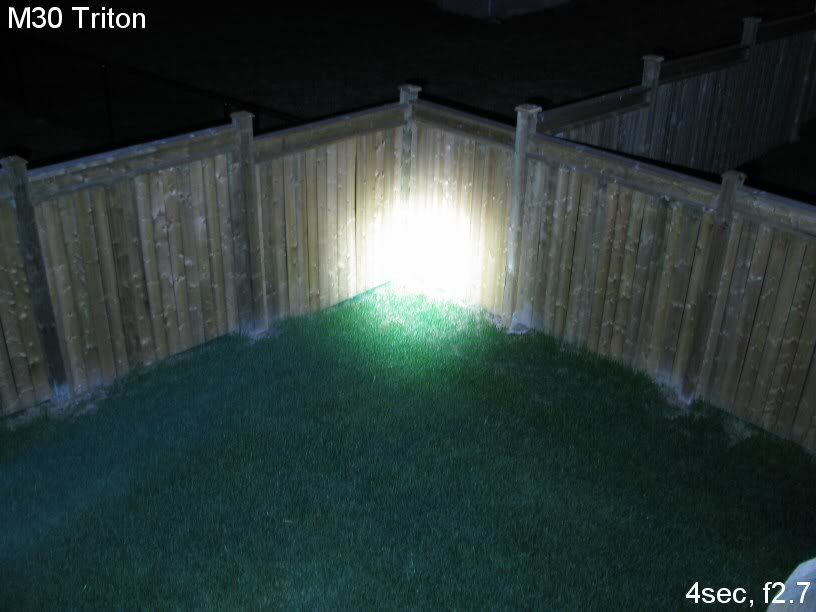
And here are some lower exposures to better show you the hotspots:
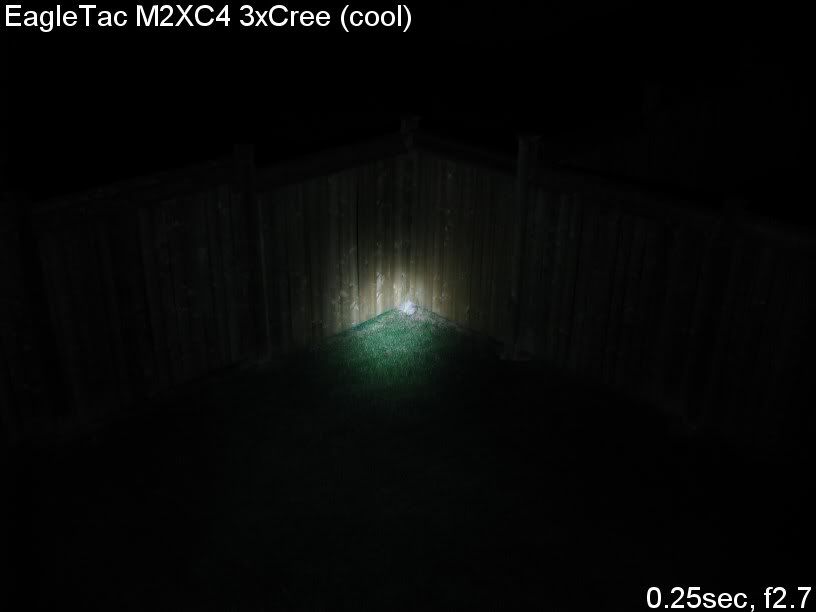
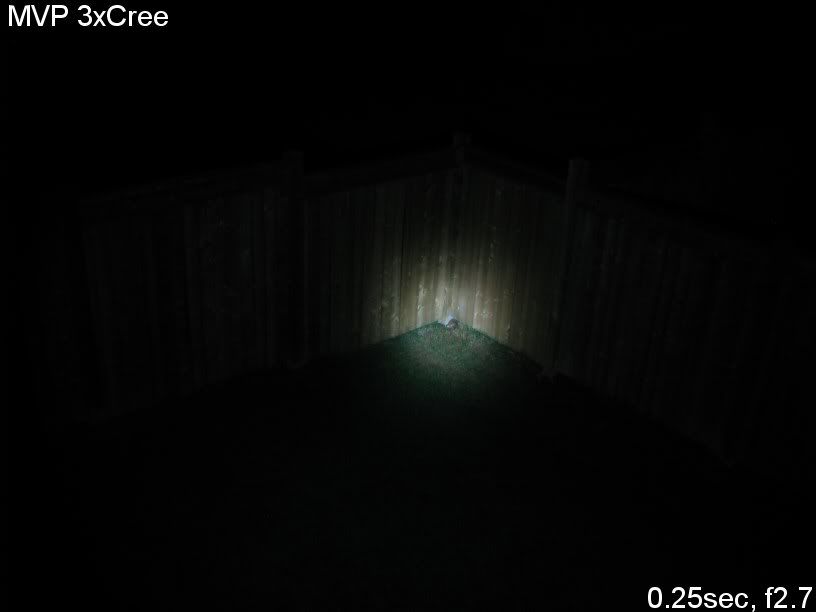
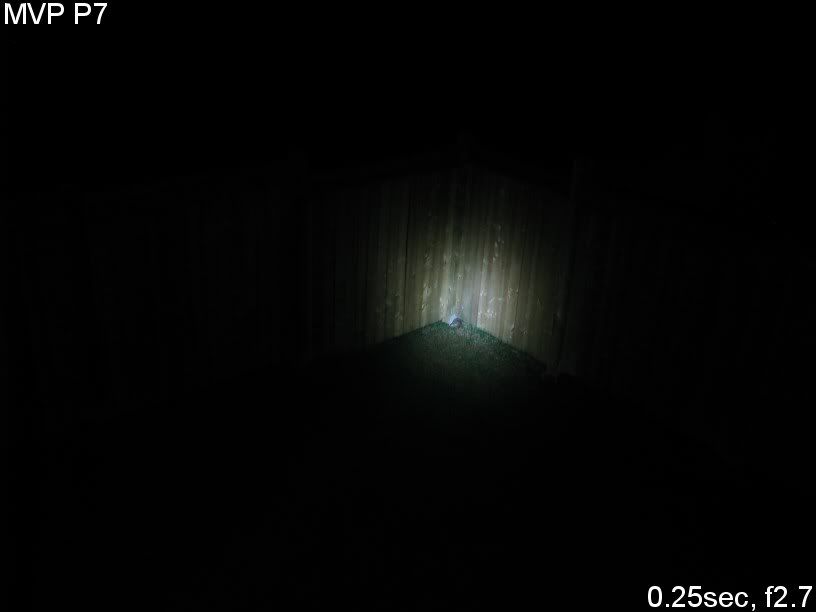
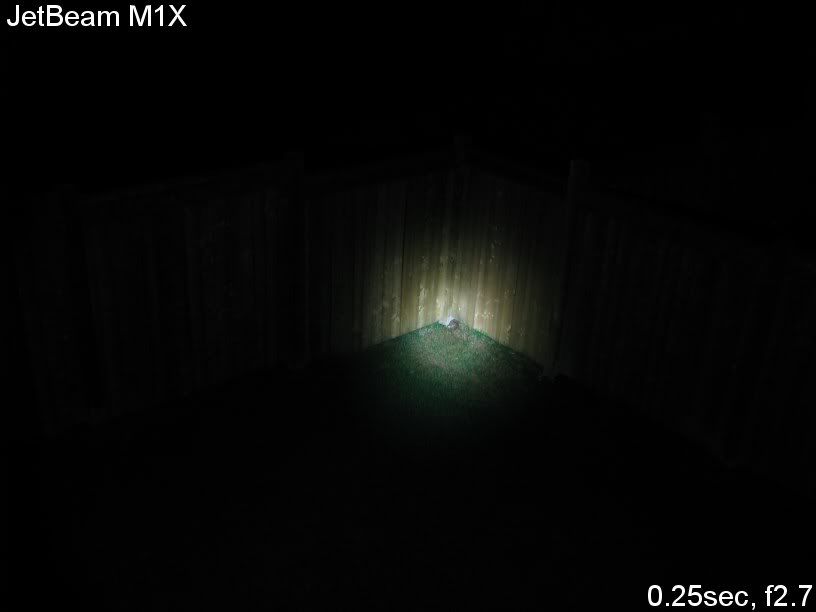
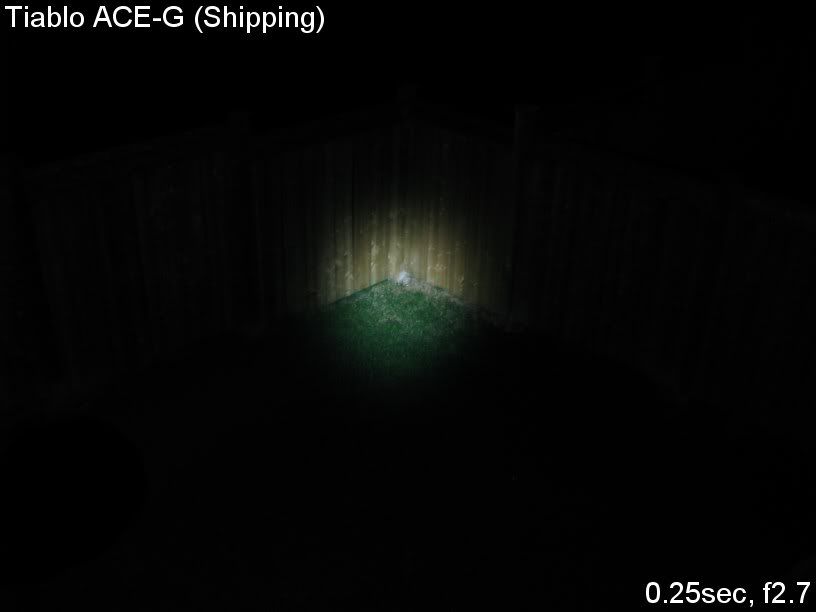
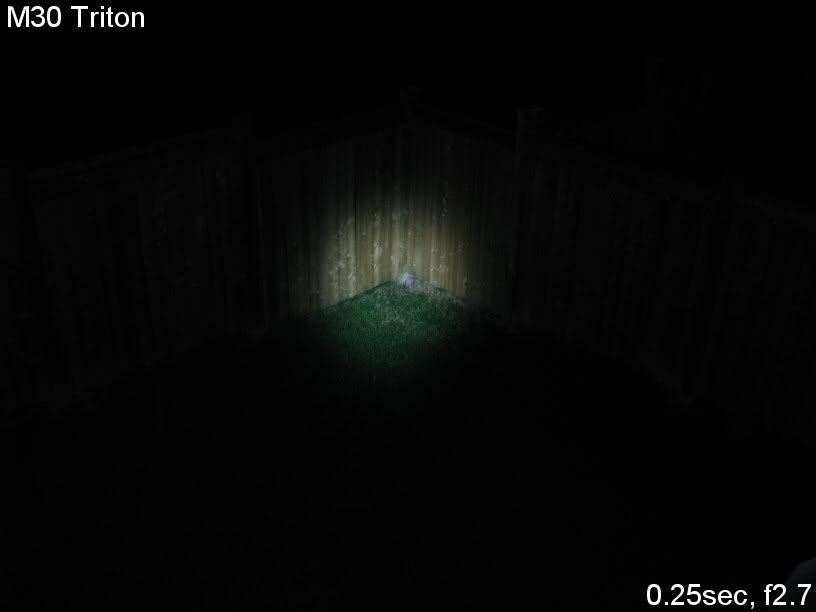
Overall output of the M2XC4 on max is among the highest of my multi-emitter lights. :thumbsup: Throw is similarly among the highest of these lights – Eagletac has done an excellent job getting the 3 emitters to focus on a common spot in my sample.
Testing Method: All my output numbers are relative for my home-made light box setup, a la Quickbeam's flashlightreviews.com method. You can directly compare all my relative output values from different reviews - i.e. an output value of "10" in one graph is the same as "10" in another. All runtimes are done under a cooling fan.
Throw values are the square-root of lux measurements taken at 5 meters from the lens, using a light meter, and then extrapolated back to estimate values for 1 meter. This will be my standard way to present throw on these types of lights from now on. The beams don't really have a chance to fully converge until typically several meters out
Some of the MC-E-based lights take a couple of minutes to settle into their regulated output state (i.e. their initial output is higher, but not for long). As such, all my output and throw numbers are taken after 2 mins of continuous runtime (on 2x18650 AW Protected cells).
Throw/Output Summary Chart:
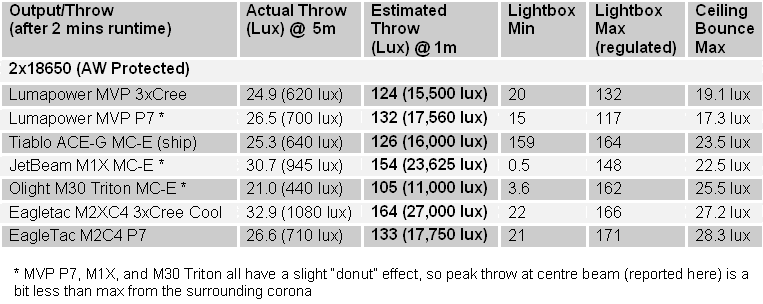
The ceiling bounce and lightbox tests confirm what the beamshots showed – that the M2XC4 has excellent throw and overall output. In fact, it is the brightest and furthest throwing of the multi-emitter lights I've tested so far. This isn't entirely surprising, since 3x emitter lights are capable of higher outputs than the quad-die MC-E or P7 lights (as the individual emitters can be driven harder if properly heatsinked).
In fact, it is the brightest and furthest throwing of the multi-emitter lights I've tested so far. This isn't entirely surprising, since 3x emitter lights are capable of higher outputs than the quad-die MC-E or P7 lights (as the individual emitters can be driven harder if properly heatsinked).
Output/Runtime Comparison
All 18650 runtimes were done on AW protected cells (2200mAh), except for the one run below labelled EAGLETAC which used the provided cells (2400mAh rated)
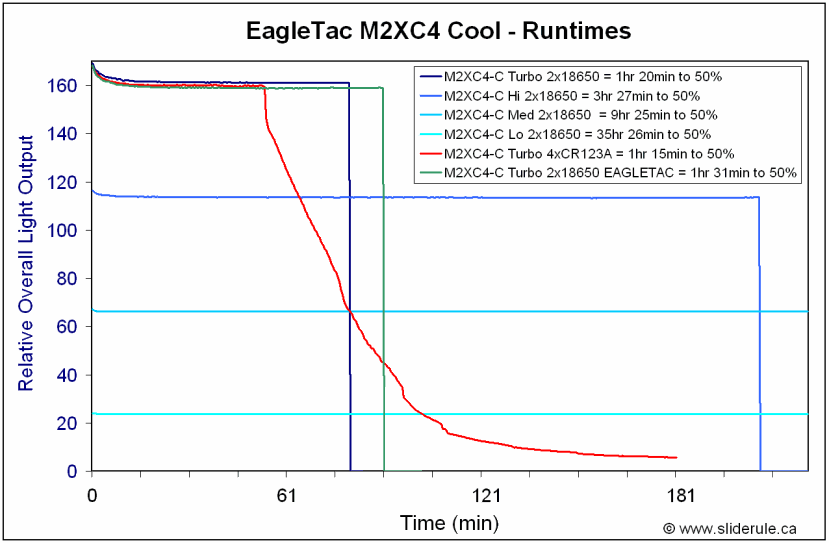
A couple of points here:
UPDATE 06/08/09: I've just updated the graphs with 4xCR123A runtimes for all lights that support this configuration.
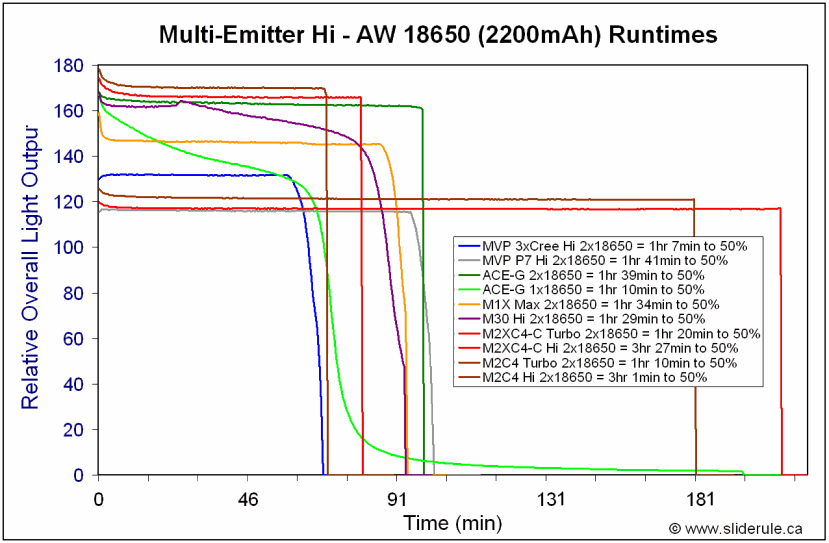
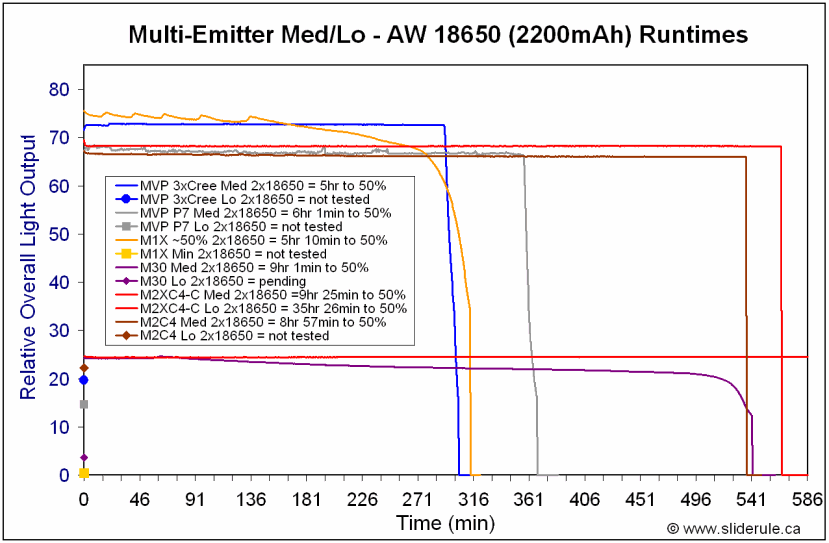
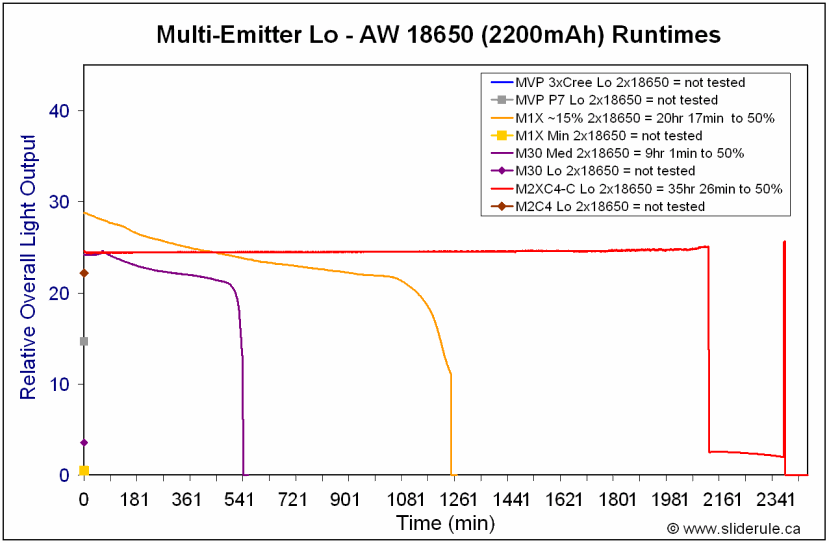
It's nice to see the performance of a well-designed constant-current circuit - note the excellent runtimes at all levels with the M2XC4. :twothumbs
The M2XC4 particularly distinguishes itself on its Med and Lo modes – see how long it runs compared to the PWM-based JetBeam M1X and Olight M30 at these levels. oo: The M30 performance seems to be an anomaly among PWM-based lights, but there is no arguing the benefits of constant-current here.
oo: The M30 performance seems to be an anomaly among PWM-based lights, but there is no arguing the benefits of constant-current here.
Interestingly, when the batteries were nearing exhaustion on the Lo mode run, the light dropped to ~1/10 its lowest output, but maintained regulation at this level (except for the brief spike back to initial Lo output right before the protection circuits kicked in)
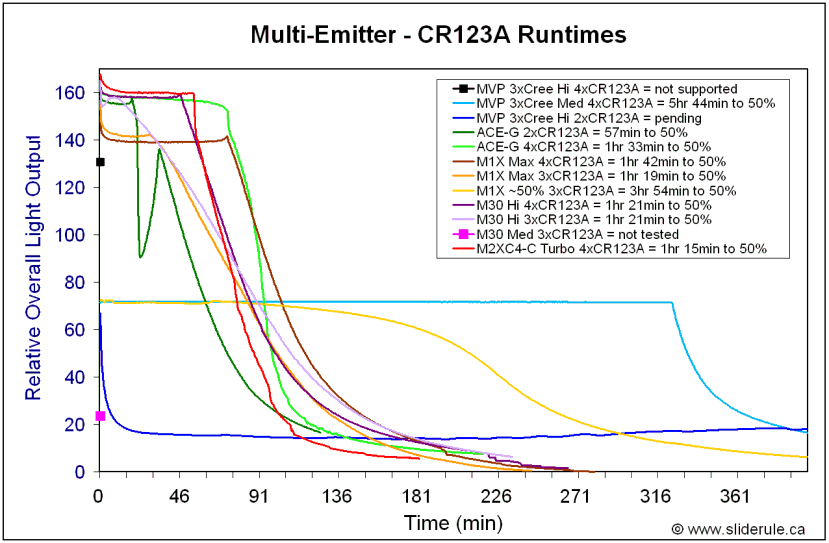
I haven't done a lot 4xCR123A runtimes, but I think you can see there are no surprises here – the light performs as expected on max on CR123A. Sorry, I don't plan to do any more of these 4x Duracell runs.
As always, there is lot more than just output/runtime efficiency to consider when choosing a light. But efficiency-fiends will find much to like here. :devil:
Potential Issues
Waterproofing of the battery tube is a potential issue given the large number of screws holding the top and bottom of the battery tube handle in place. Note that the screws may not have been fully tightened at the factory, and can potentially loosen with time, so you should periodically check their tightness. The o-ring in the tailcap can be difficult to seat properly on the clicky switch tailcap.
Light design requires use of a battery carrier.
The lack of detents or marks on the rotary dial (and the variation in the precise spacing of each mode) can make it difficult to rapidly select the level you want without "overshooting" (i.e. you will commonly find yourself getting strobed when trying to access Turbo). It may also be difficult for people with small hands to rotate the ring smoothly one-handed (there seems to be some variability in its stiffness – although mine moves freely and easily).
Due to the way the rotary dial functions, the circuit needs to be drawing a small amount of power from the batteries at all times (i.e. to detect the movement of the magnet in real time). I haven't measured the current draw on my sample, but there are other reports on the issue here on CPF. However, you can lock-out the light by unscrewing the head until the light shuts off (still has a few screw threads to hold the head in place, at least in my sample). Alternatively, with the clicky switch kit installed, you just need to keep the switch in the clicked off position.
Light is top-heavy in the M2XC4 format, likely due to a heavy-duty heatsink. I haven't received the M2C4 for testing yet, but it has been reported that weight is reduced on this model.
Preliminary Observations
EagleTac has impressed since their arrival on the flashlight scene with a series of sturdy lights with straight-forward interfaces, good reflector designs and excellent output/runtime efficiency (and at competitive prices to boot ). Although there have been a few build issues on the initial production runs of several of their other lights, these were typically resolved in short order. I have no doubt EagleTac will similarly work quickly to smooth out some of the M2XC4's rough edges (in fact, they have already demonstrated this through their participation here on CPF).
). Although there have been a few build issues on the initial production runs of several of their other lights, these were typically resolved in short order. I have no doubt EagleTac will similarly work quickly to smooth out some of the M2XC4's rough edges (in fact, they have already demonstrated this through their participation here on CPF).
In principle, I find the rotary control dial an excellent and intuitive interface. It still needs a bit of tweaking in this case, but I see it as having a lot of potential. I am not so sure about the combination with the clicky switch (except maybe as a means to break the stand-by circuit, but you can also do that in the standard configuration by simply loosening head until the light can no longer be activated). I think the interface works best in its default non-clicky arrangement. But at least the option is there for users who want it.
What I am definitely impressed with is the beam pattern and output/runtime efficiency of the M2XC4. :thumbsup: The beam pattern is very smooth, with excellent throw and very high max output. It's true the head is somewhat heavy, but I take this as a sign of the good heatsinking necessary to safely drive three emitters to such high output levels. Everything involves a trade-off, and I'm glad EagleTac has not skimped here.
The selection of output levels is very good, and their runtime performance is excellent at all levels. This is the kind of circuit performance I've been waiting to see in the multi-emitter space. :twothumbs
The package included with the light is also above average, with a good quality holster designed to fit the light. Performance of their own branded protected 18650s (2400mAh rated capacity) was as expected. I am looking forward to seeing their diffuser/filter kit, as that should provide enhanced functionality, especially for close-range tasks.
Expectations for these M2 series lights were running very high here – understandably given EagleTac's track record and their announced design choices for these lights. My impression is that EagleTac may have been trying to do too much all at once, by providing a novel UI, side-by-side battery tube design, and optional clicky switch (requiring modification to both the tailcap and the battery carrier), all in one initial release (and with 3 emitter/reflector options to boot!).
But I think it's important to keep in mind that the initial production of run of most new lights in this multi-emitter space exhibited issues that were fixed in subsequent releases (e.g. JetBeam M1X, Tiablo ACE). On the whole, I think EagleTac has delivered on its promise with the M2XC4. There are definitely some build kinks to work out (e.g. I would recommend at least making the base of the head and the handle out of a continuous piece of aluminum, to avoid one potential gap due to joining). But for now, I suggest that end users simply pay attention to o-ring placement and screw tightness to insure waterproofness.
In the end, it is an impressive light to hold and use, with an excellent beam and outstanding circuit performance. But as always, I recommend everyone carefully consider what build features and design elements most matter to you, and a select a light accordingly. After all, you will have to carry around whatever you choose, so it should fit your intended uses.
UPDATE AUGUST 12, 2009: My review of the second batch M2C4 (P7) is now up. Please see that review for an updated discussion of the build features of the M2-series lights.
Warning: very pic heavy, as always
UPDATE AUGUST 12, 2009: My review of the second batch M2C4 (P7) is now up. Please see that review for an updated discussion of the build features of the M2-series lights.
The M2X family of lights from EagleTac have been highly anticipated, due to (among other things) a novel parallel battery tube design and magnetically-controlled switching ring. Here you will see how they compare to some of the multi-emitter competition, starting with the M2XC4 3xCree (cool white).

M2XC4 Cool specs (from the manufacturer):
- Triple CREE R2 XR-E Cool White LED
- Type-III Hard-Anodized Aluminum Construction
- Constant Current Regulation Output
- All-in-one Digital Rotary Switch with Off Position and Tactical Strobe, made of Re-enforced Polycarbonate with Smooth Rubber Coating
- Dual-Slot Loaded Battery Tray System, Re-enforced by Anodized Aluminum Construction and Stainless Steel Mounting Screws, fits CR123A and 18650
- Custom Fitting Silicon O-rings and Rubber O-rings for Water Resistance (IPX8 Standard)
- Gold Plated Copper Contacts for Superior Conductivity and Durability
- Type-III Hard-Anodized Aluminum Tail-Cap with Tail-Standing and Lanyard Attachment Ability
- Thermal Management Treatment for Continuous High Output
- Syntax I Anti-Reflector Coated and Hardened Shock-Mounted Window
- Removable Smooth Crenelated Stainless Steel Bezel
- Output Modes: Strobe > 100% (800 lumens) <> 40% (360 lumens) <> 3.5 % (40 lumens) <> Off
- Runtimes (4x123A): Strobe <> 1.2hr <> 3.5hr <> 9.5 hr <> 45hr <> Off
- Runtimes (2x18650): Strobe <> 1.5hr <> 4.5hr <> 12.5 hr <> 55hr <> Off
- Included accessories: Paracord Lanyard with Position Lock, Rigid Nylon Holster with Adjustable Mounting for Different Belt Sizes, Spare O-ring
- Optional accessories: Filter Kit (Red/Blue/Green/IR) , Diffuser Kit, Window Protector Cap, 123A Battery Magazine Holder, M2 Additional Battery Tray


The EagleTac comes with the standard set of extras, like extra o-rings, wrist lanyard, warranty card and manual, and a few extras like primary battery holders, and a good quality nylon case that fits the light well. Also included with this initial run is the optional clicky switch kit (more on that in a moment).
EagleTac is preparing to offer a number of additional accessories that can be purchased separately, such as a diffuser and colored filters. With this review sample, they also included two of their own branded protected 18650 batteries (2400mAh rated capacity).

One of the most obviously distinctive features of the M2X series of lights is their parallel battery configuration. This is achieved through the use of a battery carrier inside the "handle" of the light. Note the all-black type III (HA) anodizing. My sample came very well lubed.



18650 batteries fit fairly snugly inside the carrier, but I recommend you use the included primary cell holder tubes for CR123A (prevents rattle, and holds everything together well).
The battery/body tube is attached to the tail-plate and head region base by two series of four small screws. Here is the the head region:


Note the presence of o-rings on each of four screws (these are needed for waterproofness, given the design). Here is the tail region, in stock form:


The standard tailcap is a different design than the head region, and the main o-ring appears to be sufficient to provide sufficient waterproofness (thus no o-rings on these screws). The light can tailstand in this default configuration, and there is an attachment point for the lanyard.
The light also comes with an optional clicky-switch kit:



To swap in the clicky, you will need to disassemble both the back plate and the rear of the battery carrier. This requires the proper tool – a small Phillips-head jeweler's screwdriver. Care has to be used when assembling/disassembling so that you don't actually strip the screws – this is a fairly delicate procedure. The screws on my battery carrier required a lot of force to undo.
 I also found it a bit tricky to properly seat the o-ring on the clicky switch module. If you are not careful, the o-ring will bulge inward and reduced waterproofness. The design of the flat metal tail piece seems to hold the o-ring in place better. In fact, I had better success by using the original o-ring instead of the replacement that came with the clicky switch kit.
I also found it a bit tricky to properly seat the o-ring on the clicky switch module. If you are not careful, the o-ring will bulge inward and reduced waterproofness. The design of the flat metal tail piece seems to hold the o-ring in place better. In fact, I had better success by using the original o-ring instead of the replacement that came with the clicky switch kit.

The 3xCree M2X lights use a common reflector with 3 partially overlapping wells for the emitters. This will give something of a "daisy" beam pattern up-close, but won't be an issue at a distance. My sample is the one with "cool" ~6000K color temperature Cree R2 emitters. Note the removable stainless steel bezel ring with slight crenelations.

Key to using the light is the rotary grip ring at the base of the head. This is made of polycarbonate (i.e. plastic) with a fairly "grippy" feel. It slides smoothly over ~110 degree arc, which runs in sequence as you turn clockwise from Off, through Lo, Med, Hi, Turbo, and Strobe (measured at 8 Hz on my sample). I've tried to illustrate this graphically below, starting at the 12 o'clock position and turning to the right (clockwise if holding the light and pointing away from you).

This rotary dial controls mode switching by the presence of a small embedded magnet. As it passes over various control points on the circuit, it triggers the different modes. Note that the modes are not evenly spaced along the ring. As many users have noticed, it is hard to get into Turbo mode without accidentally over-shooting into strobe instead. There are various ways to improve this – from simple mods to prevent the grip ring from making its full arc, to resoldering components on the inside of the circuit (search the main board for some discussion threads if you are interested in learning more).
With the standard flat tailcap installed, I find this ring works well only in traditional flashlight carry mode (i.e. underhand). In overhand "tactical" stance, it is hard to control the ring. But with the forward clicky kit installed, you can set the ring to your desired output mode and simply control on/off by a thumb-press in tactical overhand stance. Note that it is not as comfortable to hold the light underhand with the clicky switch installed, since the polycarbonate tailcap piece projects out wider than the width of the battery tube "handle".
Speaking of holding it, here's how it looks in my hands:


Dimensions (no batteries installed):
Height: 160mm
Width: 49mm (solid tailcap max width), 25mm (body tube minimum width), 61mm (bezel)
Weight: 395.8g
The M2XC4 is very substantial feeling, and heavier than I had expected. The light is in fact top-heavy, suggesting a good heatsinking base in the head (I understand the P7 version is not as top-heavy – I will update when that review sample arrives). IMO, it is more comfortable to carry underhand without the clicky. Given the ergonomics, there has been some concern that the light may be awkward to carry in use for long periods of time. :shrug: While I understand these concerns, the light doesn't seem too unbalanced to me, just rather beefy.
Here's how it compares to the competition (without battery extenders in place):

(from left to right, AW 18650 protected battery, EagleTac M2XC4, Tiablo ACE-G, Olight M30 Triton, JetBeam M1X, , Lumapower MVP 3xCree).

Comparison Beamshots
Both lights are on Max on 2x18650 AW protected Li-ion. Distance is about 0.5 meters from a white wall.




Up close, the M2XC4 has the typical "daisy" flower appearance customary to shared 3x reflector designs. The MVP 3xCree is a bit different, since each emitter has its own separate reflector cone.
To better compare the M2XC4 to other lights, here are some outdoor shots focused on a point ~30 feet from the lights.






And here are some lower exposures to better show you the hotspots:






Overall output of the M2XC4 on max is among the highest of my multi-emitter lights. :thumbsup: Throw is similarly among the highest of these lights – Eagletac has done an excellent job getting the 3 emitters to focus on a common spot in my sample.
Testing Method: All my output numbers are relative for my home-made light box setup, a la Quickbeam's flashlightreviews.com method. You can directly compare all my relative output values from different reviews - i.e. an output value of "10" in one graph is the same as "10" in another. All runtimes are done under a cooling fan.
Throw values are the square-root of lux measurements taken at 5 meters from the lens, using a light meter, and then extrapolated back to estimate values for 1 meter. This will be my standard way to present throw on these types of lights from now on. The beams don't really have a chance to fully converge until typically several meters out
Some of the MC-E-based lights take a couple of minutes to settle into their regulated output state (i.e. their initial output is higher, but not for long). As such, all my output and throw numbers are taken after 2 mins of continuous runtime (on 2x18650 AW Protected cells).
Throw/Output Summary Chart:

The ceiling bounce and lightbox tests confirm what the beamshots showed – that the M2XC4 has excellent throw and overall output.
Output/Runtime Comparison
All 18650 runtimes were done on AW protected cells (2200mAh), except for the one run below labelled EAGLETAC which used the provided cells (2400mAh rated)

A couple of points here:
- The M2XC4 regulation pattern is excellent on all batteries, perfectly flat at all levels initially
- Output levels seem very evenly spaced - remarkably so, in fact.
- Runtime is also excellent, but you'll see that more clearly in the detailed comparisons below.
- Note also the performance of the included EagleTac protected 18650 batteries. The 2400mAh rating appears to be believable relative to the 2200mAh-rated AW protected cells.
UPDATE 06/08/09: I've just updated the graphs with 4xCR123A runtimes for all lights that support this configuration.



It's nice to see the performance of a well-designed constant-current circuit - note the excellent runtimes at all levels with the M2XC4. :twothumbs
The M2XC4 particularly distinguishes itself on its Med and Lo modes – see how long it runs compared to the PWM-based JetBeam M1X and Olight M30 at these levels.
Interestingly, when the batteries were nearing exhaustion on the Lo mode run, the light dropped to ~1/10 its lowest output, but maintained regulation at this level (except for the brief spike back to initial Lo output right before the protection circuits kicked in)

I haven't done a lot 4xCR123A runtimes, but I think you can see there are no surprises here – the light performs as expected on max on CR123A. Sorry, I don't plan to do any more of these 4x Duracell runs.

As always, there is lot more than just output/runtime efficiency to consider when choosing a light. But efficiency-fiends will find much to like here. :devil:
Potential Issues
Waterproofing of the battery tube is a potential issue given the large number of screws holding the top and bottom of the battery tube handle in place. Note that the screws may not have been fully tightened at the factory, and can potentially loosen with time, so you should periodically check their tightness. The o-ring in the tailcap can be difficult to seat properly on the clicky switch tailcap.
Light design requires use of a battery carrier.
The lack of detents or marks on the rotary dial (and the variation in the precise spacing of each mode) can make it difficult to rapidly select the level you want without "overshooting" (i.e. you will commonly find yourself getting strobed when trying to access Turbo). It may also be difficult for people with small hands to rotate the ring smoothly one-handed (there seems to be some variability in its stiffness – although mine moves freely and easily).
Due to the way the rotary dial functions, the circuit needs to be drawing a small amount of power from the batteries at all times (i.e. to detect the movement of the magnet in real time). I haven't measured the current draw on my sample, but there are other reports on the issue here on CPF. However, you can lock-out the light by unscrewing the head until the light shuts off (still has a few screw threads to hold the head in place, at least in my sample). Alternatively, with the clicky switch kit installed, you just need to keep the switch in the clicked off position.
Light is top-heavy in the M2XC4 format, likely due to a heavy-duty heatsink. I haven't received the M2C4 for testing yet, but it has been reported that weight is reduced on this model.
Preliminary Observations
EagleTac has impressed since their arrival on the flashlight scene with a series of sturdy lights with straight-forward interfaces, good reflector designs and excellent output/runtime efficiency (and at competitive prices to boot
In principle, I find the rotary control dial an excellent and intuitive interface. It still needs a bit of tweaking in this case, but I see it as having a lot of potential. I am not so sure about the combination with the clicky switch (except maybe as a means to break the stand-by circuit, but you can also do that in the standard configuration by simply loosening head until the light can no longer be activated). I think the interface works best in its default non-clicky arrangement. But at least the option is there for users who want it.
What I am definitely impressed with is the beam pattern and output/runtime efficiency of the M2XC4. :thumbsup: The beam pattern is very smooth, with excellent throw and very high max output. It's true the head is somewhat heavy, but I take this as a sign of the good heatsinking necessary to safely drive three emitters to such high output levels. Everything involves a trade-off, and I'm glad EagleTac has not skimped here.
The selection of output levels is very good, and their runtime performance is excellent at all levels. This is the kind of circuit performance I've been waiting to see in the multi-emitter space. :twothumbs
The package included with the light is also above average, with a good quality holster designed to fit the light. Performance of their own branded protected 18650s (2400mAh rated capacity) was as expected. I am looking forward to seeing their diffuser/filter kit, as that should provide enhanced functionality, especially for close-range tasks.
Expectations for these M2 series lights were running very high here – understandably given EagleTac's track record and their announced design choices for these lights. My impression is that EagleTac may have been trying to do too much all at once, by providing a novel UI, side-by-side battery tube design, and optional clicky switch (requiring modification to both the tailcap and the battery carrier), all in one initial release (and with 3 emitter/reflector options to boot!).
But I think it's important to keep in mind that the initial production of run of most new lights in this multi-emitter space exhibited issues that were fixed in subsequent releases (e.g. JetBeam M1X, Tiablo ACE). On the whole, I think EagleTac has delivered on its promise with the M2XC4. There are definitely some build kinks to work out (e.g. I would recommend at least making the base of the head and the handle out of a continuous piece of aluminum, to avoid one potential gap due to joining). But for now, I suggest that end users simply pay attention to o-ring placement and screw tightness to insure waterproofness.
In the end, it is an impressive light to hold and use, with an excellent beam and outstanding circuit performance. But as always, I recommend everyone carefully consider what build features and design elements most matter to you, and a select a light accordingly. After all, you will have to carry around whatever you choose, so it should fit your intended uses.
UPDATE AUGUST 12, 2009: My review of the second batch M2C4 (P7) is now up. Please see that review for an updated discussion of the build features of the M2-series lights.
Last edited:


